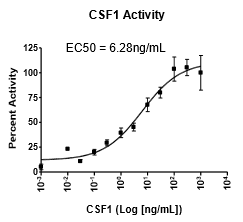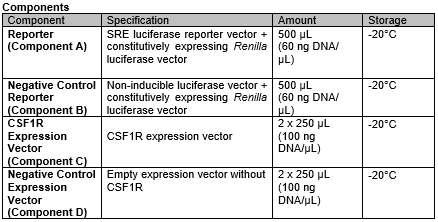CSF1R / SRE Reporter Kit (MAPK/ERK Signaling Pathway)
The CSF1R SRE Reporter Kit is designed for monitoring the activity of the CSF1R signaling pathway in cultured cells. The kit contains a transfection-ready vector for CSF1R and SRE luciferase reporter vector. Upon ligand binding, active CSF1R will initiate the MAPK/ERK signaling pathway, leading to expression of the SRE-controlled reporter. This reporter contains the firefly luciferase gene under the control of multimerized SRE responsive elements located upstream of a minimal promoter. The SRE reporter is premixed with a constitutively-expressing Renilla luciferase vector that serves as an internal control for transfection efficiency.
The kit also includes a non-inducible firefly luciferase vector premixed with constitutively- expressing Renilla luciferase vector as a negative control. The non-inducible luciferase vector contains the firefly luciferase gene under the control of a minimal promoter, without any additional response elements. The negative control is critical for determining pathway-specific effects and the background luciferase activity.
Purchase of this cell line is for research purposes only; commercial use requires a separate license. View the full terms and conditions.
• Mammalian cell line and appropriate cell culture medium
• 96-well tissue culture plate or 96-well tissue culture-treated white clear-bottom assay plate
• Transfection reagent for mammalian cell line [We use Lipofectamine™ 2000 (Invitrogen #11668027) + Opti-MEM I Reduced Serum Medium (Invitrogen #31985-062). However, other transfection reagents work equally well.]
• Recombinant Human CSF1 (BPS Bioscience, #90215-B) or Recombinant Human IL34 (Biolegend, #577904)
• Low serum (0.5% FBS) growth medium optimized for parental cell type
For HEK293 cell lines use
BPS Medium 8 (BPS Bioscience, #79385): MEM medium (Hyclone #SH30024.01) supplemented with 0.5% FBS (Invitrogen #26140-079), 1% non-essential amino acids (Hyclone #SH30238.01), 1 mM Na pyruvate (Hyclone #SH30239.01), 1% Penicillin/Streptomycin (Hyclone SV30010.01)
• TWO-Step Luciferase (Firefly & Renilla) Assay
TWO-Step Luciferase (Firefly & Renilla) Assay (BPS Bioscience, #60683): This system assays cells directly in growth medium. It can be used with any luminometer. Automated injectors are not required.
• Luminometer
Colony Stimulating Factor 1 Receptor (CSF1R, CD115, M-CSF-R) is the receptor for the cytokine CSF1 (MCSF; CSF-1), which controls the growth, function, and differentiation of macrophages. This interaction drives the development and survival of Tumor-Associated Macrophages (TAMs), which in turn suppress the local immune response to the cancer. An alternative ligand is IL-34, which has been implicated in neuroprotective and survival signals following brain injury and neurodegeneration.
As a tyrosine kinase transmembrane receptor, activation of CSF1R by its ligand initiates a vast array of intracellular activity, including activation of the MAPK/ERK signaling pathway. When phosphorylated by ERK, Elk1 forms a complex with Serum Response Factor (SRF) and binds to Serum Response Element (SRE), resulting in the expression of numerous mitogen-inducible genes.
1. Cannarile, Michael A., et al. “Colony-Stimulating Factor 1 Receptor (CSF1R) Inhibitors in Cancer Therapy.” J. Immunother. Cancer, 5(1): 53 (2017)
2. Liu, Yang, and Xuetao Cao. “The Origin and Function of Tumor-Associated Macrophages.” Cellular Molec. Immunology, 12(1): 1–4 (2014).
3. Luo, Jian, et al. “Colony-Stimulating Factor 1 Receptor (CSF1R) Signaling in Injured Neurons Facilitates Protection and Survival.” J. Exp. Med., 210(1): 157–172 (2013).
4. Yao, G.-Q., et al. “CSF-1 Induces Fos Gene Transcription and Activates the Transcription Factor Elk-1 in Mature Osteoclasts.” Calc. Tissue Int., 76(5): 371–378 (2005).




